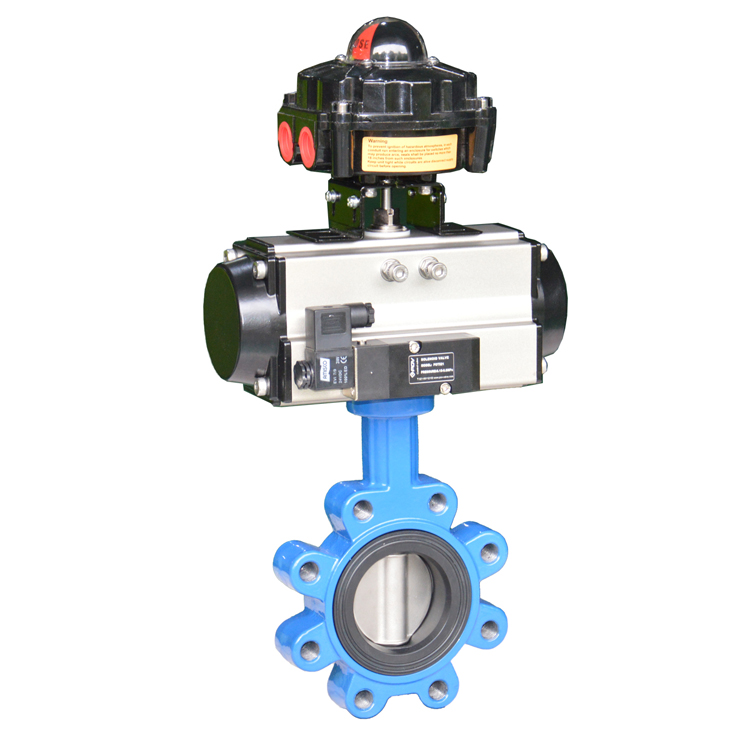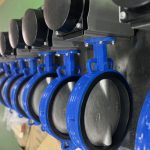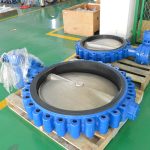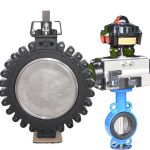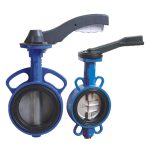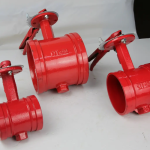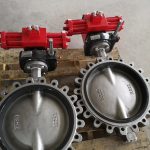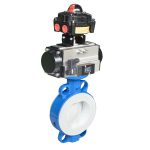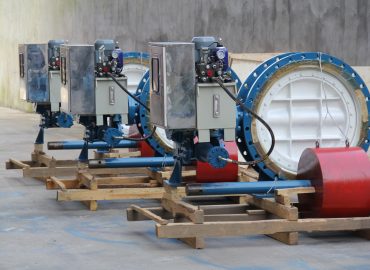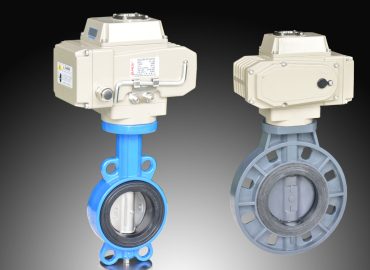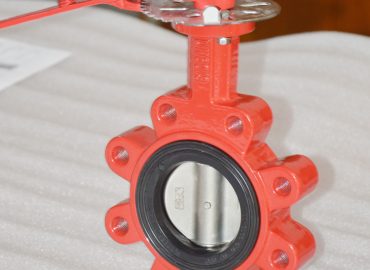In the realm of fire safety, the choice of valve systems is not just a matter of functionality—it’s a matter of life and death. As a globally recognized authority in valve manufacturing, we understand the critical role that valves play in effective fire sprinkler systems. That’s why today, we delve deep into the mechanics and applications of two key players in this arena: grooved and wafer butterfly valve. With a focus on their use within the American fire safety standards, we’ll explore the design, function, and strategic advantages of these valves, equipping you with the knowledge to make informed decisions for your fire protection needs.
Introduction
In the context of fire sprinkler systems in the USA, the grooved and wafer butterfly valve stand out due to their unique designs and functionalities. The wafer butterfly valve, as detailed in QRFS’s blog, is engineered for compatibility with flanged piping systems and is held securely in place using two flanges and a series of nuts and bolts. This design contributes to the effectiveness of fire protection systems by providing a reliable mechanism for controlling water flow. On the other hand, the grooved butterfly valve represents another essential tool in fire safety. According to Dutco Tennant, these valves control water flow in standpipe systems and fire sprinklers using a thin, rotating disc. This type of valve allows for efficient regulation or isolation of water flow, which is crucial in fire suppression efforts. Both the grooved and wafer butterfly valve are commonly used in fire protection systems, as noted by DBAO Valve, signifying their significance and widespread acceptance in the industry. These valves, being lightweight and cost-effective, ensure that fire sprinkler and standpipe systems function optimally. NIBCO, for instance, offers high-performance butterfly valve in a broad size range with wafer lug, grooved, or press end connections, indicating the versatility and adaptability of these valves in various fire protection systems. In conclusion, both grooved and wafer butterfly valve play significant roles in fire sprinkler systems within the American fire safety standards, each bringing specific advantages to the table, thereby ensuring efficient and effective fire protection.
Brief overview of the importance of valves in fire sprinkler systems.
In the intricate world of fire protection systems, valves stand as indispensable components, serving as the gatekeepers of water flow and pressure regulation. Their role is undeniably critical in ensuring that these systems function optimally during emergencies. When a fire breaks out, the responsiveness, reliability, and efficiency of a sprinkler system largely hinge on the performance of its integrated valves. These devices control the distribution of water within the system, enabling a rapid, targeted response that can minimize property damage and save lives. Valves also facilitate routine maintenance and testing procedures by isolating certain sections of the system, allowing for thorough checks without disrupting the entire operation. In essence, the functionality of fire sprinkler systems is intrinsically tied to the performance of their valves, underlining the importance of choosing high-quality, reliable valve solutions from certified and globally recognized manufacturers.
Introduction to the two types of valves that will be discussed: grooved and wafer butterfly valve.
As a global authority in valve manufacturing, we take pride in our extensive portfolio that caters to various industrial needs. Today, we spotlight two key players in our offering: the grooved and wafer butterfly valves. The grooved butterfly valve, known for its precision-engineered interface with grooved end connections, provides an optimal solution for systems requiring streamlined water flow control. Its design facilitates installation, maintenance, and robust operation in demanding environments. On the other hand, the wafer butterfly valves, characterized by its compact and lightweight design, is ideally suited for flanged piping systems. Installed between two flanges using a series of bolts, this valve offers reliable control of fluid flow, ensuring efficient operation of your fire protection systems. Both these valves exemplify our commitment to quality, innovation, and performance, embodying the technical prowess that our brand is renowned for in the industry.
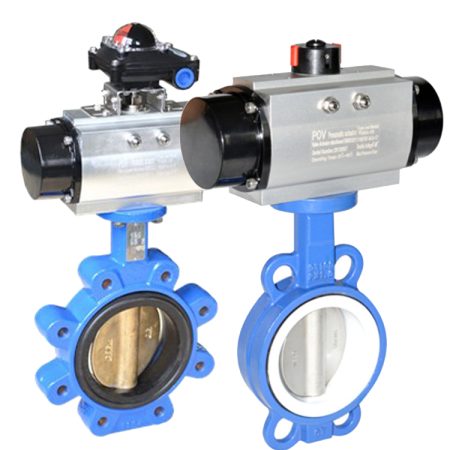
Understanding Valves
In the realm of fluid control systems, understanding the role and function of valves is pivotal. As a global leader in valve manufacturing, we leverage our technical expertise and industry knowledge to produce high-performance, quality-assured valves that regulate flow and pressure within a myriad of systems. Valves are essentially control devices, designed to modulate fluid flow in response to signals from independent devices like flow meters or temperature gauges. They operate by opening, closing, or partially obstructing passageways in a system, thereby controlling fluid flow rates, direction, and pressure. The two primary types of valves in our portfolio, the grooved and wafer butterfly valves, exemplify our commitment to delivering innovative and reliable solutions for diverse applications. These valves, known for their robust design and precision engineering, offer efficient fluid control in various systems, including fire protection. Our stringent quality control measures, coupled with our globally recognized certifications, ensure that every valve we manufacture meets the highest standards of performance and reliability. With our deep-rooted expertise and extensive global reach, we remain at the forefront of the valve manufacturing industry, committed to providing our clients with top-tier, technologically advanced valve solutions.
Detailed explanation of what valves are.
Valves, in the most technical sense, are mechanical devices that regulate, direct, and control the flow of fluids such as gases, liquids, fluidized solids, or slurries. They accomplish this by opening, closing, or partially obstructing various passageways. As an integral part of many industrial systems, valves play a crucial role in optimizing operational efficiency and safety. Their functionality is based on the principle of fluid dynamics, where they control fluid flow by varying the size of the flow passage as directed by signals from controllers. The valve’s design can include various types of ports, seating surfaces, and methods of actuation, each tailored to meet specific operational requirements. Our valves are precision-engineered, ensuring resilience and reliability even under the most demanding conditions. As a testament to our commitment to quality and performance, our valves are certified and adhere to stringent global standards, reinforcing our status as a trusted leader in the valve manufacturing industry.
Description of how valves work in a fire sprinkler system.
In a fire sprinkler system, valves play an indispensable role in ensuring optimal functionality and safety. The system is engineered to respond to heat, and upon detecting a significant temperature rise, it activates the sprinkler heads. The valves come into play here, controlling the flow of water to these activated sprinkler heads. Designed for precision and reliability, the valves regulate the pressure and volume of water that is dispatched, ensuring an efficient response to the detected fire. Two types of valves commonly used in such systems are grooved and wafer butterfly valves. The grooved butterfly valve, with its meticulously designed grooved end connections, provides a streamlined control of water flow. The wafer butterfly valve, renowned for its compact design, fits perfectly in flanged piping systems and offers reliable fluid control. Both these valves, characterized by their robust design and precision engineering, adhere to our stringent quality control measures and globally recognized certifications, making them the ideal choice for fire protection systems.
Importance of selecting the right type of valve for the system.
In the world of fluid control systems, the selection of the right type of valve is of paramount importance. This decision can significantly impact the operational efficiency, safety, and longevity of the system. Each valve is designed with specific characteristics to handle distinct flow conditions, pressures, and temperatures, making it vital to understand these parameters when selecting a valve. Our wide-ranging portfolio of valves, including grooved and wafer butterfly valves, caters to various industry-specific needs. These valves are renowned for their robust design, precision engineering, and adherence to our stringent quality control measures and globally recognized certifications. By choosing the correct valve type for your system, you can optimize fluid control, minimize potential system failures, and maximize the lifespan of your equipment. As a global leader in valve manufacturing, we possess the technical expertise and industry knowledge to guide you in making an informed choice, reinforcing our commitment to delivering innovative and reliable solutions for diverse applications.
Grooved Butterfly Valve
Grooved butterfly valves are a testament to our commitment to innovation, precision, and reliability in the valve manufacturing industry. These meticulously designed valves feature grooved end connections that provide a streamlined control of fluid flow, making them an integral component of many high-performing fluid control systems. A grooved butterfly valve, as the name suggests, operates through a disc mounted on a rotating shaft. When the valve is fully open, the disc aligns with the direction of the fluid flow. When the valve is closed, the disc rotates to obstruct the passageway, effectively stopping the flow. This simple yet effective mechanism allows for efficient fluid control, making grooved butterfly valves ideal for applications that require both throttling and on-off control. With their compact design and robust construction, these valves offer unmatched durability, ensuring operational longevity even under the most demanding conditions. As a global leader in the valve manufacturing industry, we adhere to stringent quality control measures and globally recognized certifications. Our grooved butterfly valves, like all our products, exemplify this commitment to quality and performance, reinforcing our status as a trusted provider of sophisticated fluid control solutions.
Detailed description of grooved butterfly valve, including their design and function.
As a leader in the valve manufacturing industry, we bring to you grooved butterfly valves, a hallmark of our technical prowess and commitment to quality. Engineered with precision, these valves feature grooved end connections that ensure a controlled and efficient fluid flow. The operational mechanism of this type of valve is based on a rotating disc mounted on a shaft. When the valve is fully open, the disc aligns with the fluid flow direction, allowing an unrestricted flow. Upon closure, the disc rotates to block the passageway, effectively halting the flow. This mechanism enables both throttling and on-off control, rendering grooved butterfly valves versatile for a wide array of applications. The compact design and robust construction of these valves ensure resilience and durability, contributing to their long operational lifespan even under demanding conditions. Adhering to globally recognized certifications and stringent quality control measures, our grooved marine butterfly valve epitomize superior performance and reliability, thereby reinforcing our brand’s authority in providing advanced fluid control solutions.
Discussion on the advantages of using grooved butterfly valve in fire sprinkler systems.
Leveraging our extensive expertise and authority in the valve manufacturing industry, we present the grooved butterfly valves, a superior choice for fire sprinkler systems. These valves, backed by globally recognized certifications and stringent quality control measures, offer distinct advantages. Their compact design and robust construction make them a space-efficient and durable solution, ensuring reliable functionality even in high-pressure scenarios typical of fire sprinkler systems. The disc’s rotational mechanism allows for both throttling and on-off control, providing precise flow regulation to enhance system effectiveness. Furthermore, the grooved end connections facilitate easy installation and maintenance, reducing operational downtime. By opting for our grooved butterfly valves, you not only benefit from their technical superiority but also align your fire sprinkler systems with a global leader in valve manufacturing, thereby assuring quality, reliability, and optimal performance.
Case studies or examples of industry applications where grooved butterfly valve are used.
Grooved butterfly valves, with their versatile design and efficient functionality, have found extensive application across a variety of industries. For instance, in a high school renovation project, General Piping Inc. relied on these valves to meet strict deadlines, demonstrating their ease of installation and reliable operation. Another case study illustrates the use of custom o-ring grooves on both faces of the valve, allowing for effective sealing without the need for additional components. This innovation further enhances the valve’s utility in diverse settings. In the realm of water supply and wastewater treatment, grooved butterfly valves are favored for their precise flow control and robust construction. Moreover, their application in non-corrosive industrial contexts, such as irrigation and water trucks, underscores their adaptability and superior performance. These case studies bear testimony to the fact that our grooved butterfly valves, with their unique features and reliable operation, are a preferred choice in various industry applications.
Wafer Butterfly Valve
Proudly standing at the forefront of the valve manufacturing industry, we present to you our high-caliber wafer butterfly valves. Constructed with meticulous expertise, these valves are designed to provide optimal control over fluid flow in various industrial applications. A wafer butterfly valve features a disc mounted on a rotating shaft. When the valve is fully open, the disc aligns with the flow direction, allowing unrestricted fluid passage. Conversely, when the valve is closed, the disc rotates to obstruct the passageway, effectively halting the flow. This operational mechanism facilitates both throttling and on-off control, marking the wafer butterfly valves as versatile equipment for a range of applications. The wafer-style design, characterized by its compact size and easy installation between flanges, makes these valves an efficient solution for systems where space is a constraint. Our wafer butterfly valves are built robust to withstand demanding conditions, ensuring a long service life. Adhering strictly to globally recognized certifications and rigorous quality control measures, we guarantee that our wafer butterfly valves deliver superior performance and reliability. With our commitment to technical excellence and global reach, we are confident that our wafer butterfly valves will meet and exceed your expectations, reinforcing our brand’s authority in providing advanced fluid control solutions.
Detailed description of wafer butterfly valve, including their design and function.
In the realm of valve manufacturing, our wafer butterfly valves embody the apex of precise engineering and robust design. A wafer butterfly valve is distinguished by a disc positioned on a rotating shaft within the valve body. This disc, aptly termed the ‘butterfly’, is the heart of the control mechanism. When the valve is fully open, the disc aligns with the direction of the flow, offering minimal resistance and promoting fluid passage. On the contrary, when the valve is closed, the disc rotates to obstruct the flow path, effectively ceasing fluid movement. This operational principle provides dual functionality: throttling and on-off control, marking these valves as versatile assets in various industrial applications. The design of the wafer butterfly valve is characterized by its compact size and the ability to be sandwiched between flanges, making it an efficient solution for systems where space optimization is essential. Crafted to withstand demanding conditions and rigorous usage, these valves promise a prolonged service life. Upholding our globally recognized certifications and stringent quality control measures, we assure that our wafer butterfly valves deliver unmatched performance and reliability. Our commitment to technical superiority and global reach ensures that our wafer butterfly valves stand unrivaled, reinforcing our position as a leading authority in advanced fluid control solutions.
Discussion on the advantages of using wafer butterfly valves in fire sprinkler systems.
In the realm of fire protection systems, the adoption of our wafer butterfly valves offers a host of significant advantages. Their inherent design excellence and robust construction allow for seamless integration and superior functionality within fire sprinkler systems. The compact nature of these valves, facilitated by the wafer-style design, ensures they can be efficiently accommodated in space-constrained environments. This compactness does not compromise performance; the disc’s rotational mechanism provides precise flow control, enabling quick activation or deactivation of sprinkler systems as required. Furthermore, their durability under demanding conditions affirms their long service life, reducing maintenance costs and system downtime. Our wafer butterfly valves are manufactured in strict adherence to globally recognized certifications, ensuring compliance with fire safety standards and regulations. Our stringent quality control measures further attest to their reliability in critical life-saving applications. Harnessing our global reach and technical expertise, we provide advanced fluid control solutions that enhance the effectiveness of fire sprinkler systems, reinforcing our position as an authority in the valve manufacturing industry.
Case studies or examples of industry applications where wafer butterfly valve are used.
Wafer butterfly valves have been integral in a multitude of industry applications, demonstrating their versatility and reliability. In the industrial fluid control sector, wafer butterfly valves have earned their reputation as reliable and efficient components. One notable case study highlights their usage in wastewater treatment facilities where their compact design and precise flow control capabilities are vital for large-diameter pipe regulation. Furthermore, they have found extensive use in sectors such as pharmaceuticals, chemical and oil, food processing, and even HVAC systems. Their ability to provide sealing against bi-directional pressure difference makes them invaluable in preventing backflow in these systems. Additionally, their use in mining operations underscores their robustness and durability under demanding conditions. Across these diverse applications, our wafer butterfly valves consistently deliver superior performance, affirming our position as an industry leader in valve manufacturing.
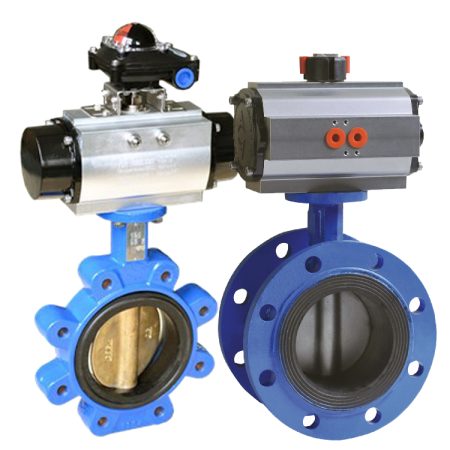
Comparison Between Grooved and Wafer Butterfly Valve
In the realm of valve manufacturing, a detailed comparison between grooved and wafer butterfly valves reveals distinct characteristics that underscore their unique functionalities in various industry applications. Grooved butterfly valves, designed with a specific end connection style, are primarily utilized in systems that require a quick, direct connection to grooved pipe ends. This design, renowned for its ease of installation and maintenance, allows for simpler system modifications and alterations. However, the simplicity of this design does not compromise its performance, as it provides reliable flow control and shut-off capabilities.
On the other hand, wafer butterfly valves, recognized for their compact design, are ideal for systems with space constraints or where weight considerations are paramount. The wafer design allows these valves to be sandwiched between two flanges in a piping system, making them an economical choice for large diameter pipes due to their lightweight and smaller face-to-face dimensions. Despite their compact size, wafer butterfly valves offer robust performance, providing both throttling and on-off control. Their ability to withstand demanding conditions and rigorous usage ensures a long service life and reduced maintenance costs.
Both grooved and wafer butterfly valves are crafted in adherence to globally recognized certifications, attesting to their high-quality construction and reliable performance. However, the choice between these two types should be guided by the specific requirements of the application, considering factors such as system design, available space, desired flow control, and operational conditions. Our commitment to technical superiority and global reach ensures that our grooved and wafer butterfly valves stand unrivaled, reinforcing our position as a leading authority in advanced fluid control solutions.
Comparative analysis of grooved and wafer butterfly valve based on factors such as cost, ease of installation, performance, maintenance, and reliability.
In the realm of valve manufacturing, both grooved and wafer butterfly valves have distinct attributes that make them suitable choices for various applications. From a cost perspective, wafer butterfly valves often have an edge due to their compact design, requiring less material, thereby reducing manufacturing costs. However, the initial lower cost of wafer butterfly valves may be offset depending on the specific application and installation requirements.
In terms of installation, grooved butterfly valves are renowned for their ease of use. Their design allows for direct connection to grooved pipe ends, enabling quicker installations and system modifications. Conversely, wafer butterfly valves, while compact, require careful alignment between two pipe flanges during installation, which can be more time-consuming.
When considering performance, both types offer robust flow control capabilities. The rotational mechanism of butterfly valves provides excellent throttling and shut-off abilities, with both grooved and wafer designs demonstrating high levels of efficiency and reliability.
Maintenance and reliability are also crucial factors to consider. Wafer butterfly valves, given their robust construction and smaller face-to-face dimensions, generally yield longer service lives and lower maintenance costs. Grooved butterfly valves, while also reliable, may require more regular maintenance due to their connection style.
In conclusion, both grooved and wafer butterfly valves have unique advantages based on varying factors. The choice between these two should be guided by the specific requirements of your application, taking into account cost, ease of installation, performance, maintenance, and reliability. As a global leader in advanced fluid control solutions, we provide both types with high-quality construction and superior performance, backed by globally recognized certifications and stringent quality control measures.
Technical specifications comparison between the two types of valves.
Harnessing our authority and expertise in the valve manufacturing industry, we provide a detailed comparative analysis of the technical specifications of grooved and wafer butterfly valves. Grooved butterfly valves, designed with a unique end connection style, are typically available in sizes ranging from 2 to 12 inches. They are rated for pressures up to 300 PSI and can operate efficiently within a temperature range of -20 to 180 degrees Fahrenheit. These valves are suitable for use with a wide array of media such as water, air, and light oil, emphasizing their versatility.
Wafer butterfly valves, on the other hand, come in a broader size range from 1.5 to 48 inches, catering to larger diameter pipes. They are designed to handle pressures up to 200 PSI and can withstand temperature ranges from -20 to 350 degrees Fahrenheit. Notably, wafer butterfly valves are compatible with a more diverse range of media, including gases, corrosive fluids, and semi-solid materials, highlighting their robustness and adaptability.
Both types of valves boast of top-tier construction materials such as ductile iron, stainless steel, and various grades of elastomers for their sealing components. This ensures high durability and resistance to wear and tear. Furthermore, both grooved and wafer butterfly valves conform to globally recognized standards and certifications, underlining our commitment to quality, reliability, and performance. The choice between these two valve types should be guided by your specific operational requirements, factoring in parameters such as pressure rating, temperature range, media compatibility, and size needs. Our technical prowess and global reach ensure that our grooved and wafer butterfly valves consistently deliver superior, reliable performance.
Discussion on how to choose between grooved and wafer butterfly valve depending on the specific needs of a fire sprinkler system.
In the critical domain of fire protection systems, the selection between grooved and wafer butterfly valves should be meticulously guided by the specific needs and demands of your fire sprinkler system. Grooved butterfly valves, with their distinct end connection style, offer a direct connection to grooved pipe ends, making them an excellent choice for systems that require rapid installation and easy maintenance. Their robust construction and reliable performance make them suitable for a wide variety of water-based fire sprinkler systems.
Conversely, wafer butterfly valves, renowned for their compact design, are ideal for systems where space constraints are a concern or where weight considerations are paramount. Despite their compact size, these valves provide robust performance, delivering both throttling and on-off flow control, which is crucial in emergency situations when rapid response is required.
However, it’s not just about the physical characteristics of these valves. The decision should also consider factors such as pressure ratings, temperature ranges, and media compatibility. For instance, if your fire sprinkler system operates under high pressure or requires a valve that can withstand a wider temperature range, a wafer butterfly valve may be more appropriate.
As a globally recognized leader in advanced fluid control solutions, we ensure our grooved and wafer butterfly valves conform to stringent quality control measures and globally recognized certifications. We are committed to providing you with superior, reliable performance that meets your specific fire protection needs. By leveraging our technical expertise and industry-specific knowledge, we can guide you in making the most suitable choice between grooved and wafer butterfly valves for your fire sprinkler system.
Compliance with USA Standards
As a trusted leader in the valve manufacturing industry, we are steadfast in our commitment to uphold and exceed the rigorous standards set by the United States for quality, safety, and performance. Our products, including grooved and wafer butterfly valves, are meticulously designed and produced in strict compliance with recognized American standards such as those established by the American Society of Mechanical Engineers (ASME), American Water Works Association (AWWA), and the Underwriters Laboratories (UL).
Our adherence to ASME standards guarantees the structural integrity and operational reliability of our valves, ensuring they can withstand the pressures and temperatures they will encounter in service. Complying with AWWA standards ensures our valves meet the highest benchmarks for use in water supply service, including rigorous testing for endurance and strength. Furthermore, our UL certification is testament to our commitment to fire safety, as our valves meet the stringent requirements for fire protection applications.
Moreover, we also comply with the American National Standards Institute (ANSI) guidelines, which provide a comprehensive framework for consistency in product performance and quality. Our valves are manufactured to ANSI class ratings, ensuring their compatibility with flanges, fittings, and other components within the same class.
Beyond these certifications, our global reach and expertise enable us to understand and meet the specific regulatory requirements of different regions, ensuring seamless integration of our products into your systems, regardless of location. As we navigate the evolving landscape of standards and regulations, we remain dedicated to delivering superior, reliable performance without compromising on safety or quality. This unwavering dedication to compliance underscores our authoritative stance in the industry and reinforces our promise of excellence to our customers worldwide.
Overview of the USA standards for fire sprinkler systems and how these relate to the selection of valves.
Fire sprinkler systems in the United States are governed by a comprehensive set of standards that ensure their effectiveness, reliability, and safety. These standards, established by authorities such as the National Fire Protection Association (NFPA) and the Occupational Safety and Health Administration (OSHA), provide detailed guidelines for the design, installation, and maintenance of these critical systems.
NFPA 13, the Standard for the Installation of Sprinkler Systems, specifies the types of systems permissible, including wet, dry, preaction, and deluge, each with unique requirements and applications. The selection of valves, being a crucial component of these systems, is highly influenced by these specifications. For example, Outside Screw and Yoke (OS&Y) type gate valves are typically chosen as major control and isolation valves in traditional fire sprinkler systems due to their robustness and reliability.
In addition, the NFPA 25 standard provides specific requirements relating to the inspection, testing, and maintenance of fire sprinkler systems, further influencing the choice of valves. Valves chosen must be durable, reliable, and easy to inspect and maintain to meet these rigorous standards.
Moreover, the American Water Works Association (AWWA) provides specific guidance on setting rates for sprinklered buildings, which can influence the selection of cost-effective valve solutions. All automatic sprinkler designs used to comply with these standards must provide the necessary discharge patterns, densities, and water flow characteristics, which are largely determined by the type of valve used.
As an industry leader, we ensure our valves meet and exceed these stringent standards, providing you with the confidence and assurance that our products will deliver superior, reliable performance in all fire protection applications.
Explanation on how grooved and wafer butterfly valve meet these standards.
As a leading authority in the valve manufacturing industry, we take pride in our grooved and wafer butterfly valves, which are meticulously designed and produced to meet the rigorous standards set by American and international regulatory bodies. Our grooved butterfly valves, with their robust construction and direct connection to grooved pipe ends, meet the stringent requirements of NFPA 13 for reliable control and isolation in fire sprinkler systems. Their design ensures rapid installation and easy maintenance, aligning with the mandates of NFPA 25 for regular inspection and upkeep.
Similarly, our wafer butterfly valves, recognized for their compact design and powerful performance, comply with AWWA guidelines for water supply service. Despite their compact size, these valves offer both throttling and on-off flow control, crucial for emergency situations when rapid response is required. They are also designed to handle high pressure and a wide temperature range, meeting the demanding requirements of OSHA guidelines.
Moreover, both our grooved and wafer pneumatic butterfly valve are manufactured to ANSI class ratings, ensuring compatibility with flanges, fittings, and other components within the same class, providing seamless integration into your systems.
Our compliance with these standards is not an endpoint but a continuous process. We continually innovate and refine our products to not just meet but exceed these standards, reinforcing our position as a trusted, authoritative leader in the industry. Our commitment to quality control, global reach, and technical expertise enables us to provide superior, reliable valves that meet your specific needs and the highest level of safety standards.
Discussion on the importance of adhering to these standards for safety and efficiency.
Adherence to the established standards in the valve manufacturing industry is not merely a formality; it’s an essential aspect of our commitment to safety and operational efficiency. These stringent guidelines, set forth by recognized authorities such as NFPA, OSHA, AWWA, and ANSI, are designed to ensure that every component of a fire sprinkler system, including valves, meets the highest benchmarks for performance, durability, and reliability.
Our adherence to these standards demonstrates our unwavering pursuit of excellence in all facets of our business. It ensures that our grooved and wafer butterfly valves perform optimally under rigorous conditions, providing reliable control and isolation when it matters most. By maintaining compatibility with flanges, fittings, and other components within the same ANSI class, we ensure seamless integration and optimal functionality of your systems, significantly enhancing operational efficiency.
Moreover, these standards serve as a testament to our commitment to safety. Whether it’s meeting NFPA’s exacting requirements for fire protection applications or complying with OSHA’s comprehensive safety regulations, we leave no stone unturned in safeguarding the well-being of our customers and their assets.
In a rapidly evolving industry landscape, adhering to these standards also enables us to stay at the forefront of innovation, continually refining our products to meet emerging challenges and exceed customer expectations. As an authoritative leader in the valve manufacturing industry, we view these standards not as constraints but as catalysts for delivering superior, reliable performance and unrivaled safety.
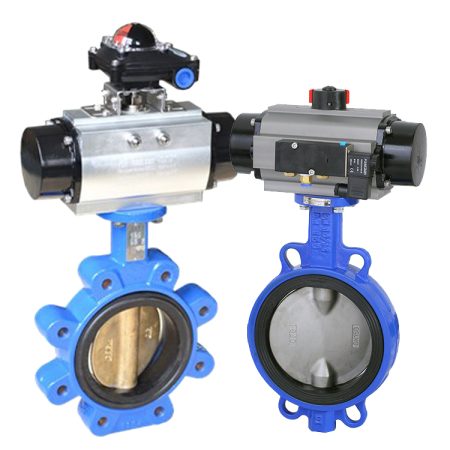
Conclusion
In the intricate world of fire protection systems, every component plays a vital role in ensuring safety and efficiency. As we’ve explored in this blog post, the roles of grooved and wafer butterfly valves in these systems are no exception. Both types of valves come with their unique strengths, making them indispensable in different applications within fire sprinkler systems.
Grooved butterfly valves, with their robust construction and direct connection to grooved pipe ends, offer reliability and ease of maintenance that align with the stringent requirements of NFPA 13 and NFPA 25. They are quick to install and simple to inspect, providing an efficient solution for control and isolation in fire sprinkler systems.
On the other hand, wafer butterfly valves, known for their compact design and high performance, provide both throttling and on-off flow control crucial for emergency situations. Their ability to handle high pressure and a wide temperature range makes them compliant with OSHA guidelines and ideal for water supply service, as stipulated by AWWA.
However, the choice between grooved and wafer butterfly valves is not a matter of one being superior over the other. Instead, it’s about understanding the specific needs of your fire protection system and choosing the valve that best meets those requirements. Here, adherence to industry standards becomes paramount, guiding the selection process and ensuring the chosen valve delivers optimal performance, durability, and reliability.
As a global leader in the valve manufacturing industry, we stand by our commitment to adhere to these rigorous standards. By doing so, we not only ensure the quality and reliability of our products but also contribute to the safety and efficiency of fire sprinkler systems across the USA. Our dedication to quality control, technical expertise, and continual innovation allows us to deliver valves that not only meet but exceed these standards.
In conclusion, whether you opt for a grooved or wafer butterfly valve, remember that each plays a critical role in the effective functioning of fire sprinkler systems. By understanding these roles and adhering to established standards, you can ensure that your fire protection system operates at its best when it matters most. After all, in the realm of fire safety, every second counts, and every component matters. Trust in our expertise, and let us help you make an informed decision for your safety and peace of mind.

Recap of the main points discussed in the blog post.
In this comprehensive discussion, we delved into the significant roles of grooved and wafer butterfly valves in fire sprinkler systems, underlining our unyielding commitment to quality and safety in the valve manufacturing industry. We explored how grooved butterfly valves, with their robust design and direct connection to grooved pipe ends, fulfill the rigorous requirements of NFPA 13 and NFPA 25, ensuring reliable control and ease of maintenance.
We also examined the merits of wafer butterfly valves – compact yet high-performing, these valves meet AWWA guidelines for water supply service and comply with OSHA’s safety regulations, offering both throttling and on-off flow control vital for emergency situations.
Moreover, we emphasized the importance of adhering to industry standards such as those set by NFPA, OSHA, AWWA, and ANSI. Compliance with these benchmarks not only testifies to the superior performance, durability, and reliability of our valves but also enhances operational efficiency and guarantees safety.
Finally, we underscored that the choice between grooved and wafer butterfly valves hinges on the specific needs of your fire protection system. As a global leader in the valve manufacturing industry, we leverage our certifications, stringent quality control, technical prowess, and industry-specific expertise to guide you in making an informed decision, ensuring optimal functionality of your fire sprinkler systems when it matters most.
Emphasis on the role that both grooved and wafer butterfly valve play in fire sprinkler systems.
In the complex field of fire protection systems, the roles of grooved and wafer butterfly valves are indispensable. These components, each with their unique capabilities, contribute significantly to the overall functionality and efficiency of fire sprinkler systems.
Grooved butterfly valves, characterized by their robust construction and direct connection to pipe ends, provide a reliable solution for control and isolation. Their design facilitates ease of maintenance and installation, aligning with the stringent guidelines of NFPA 13 and NFPA 25, which underpin their critical role in fire sprinkler systems.
Conversely, wafer butterfly valves, lauded for their compact design and high-performance capabilities, offer both throttling and on-off flow control. Their ability to operate effectively under high pressure and a wide range of temperatures makes them ideal for water supply service and emergency situations, meeting the rigorous safety regulations set by OSHA and AWWA.
As a certified global leader in the valve manufacturing industry, we emphasize the importance of selecting the right valve based on the specific needs of your fire protection system. Whether it’s a grooved or wafer butterfly valve, our commitment to quality control, technical expertise, and adherence to industry-specific standards ensures that our products deliver unmatched performance, reliability, and safety.
Final thoughts on the importance of making an informed choice when selecting valves for fire sprinkler systems.
In the realm of fire protection systems, making an informed choice when selecting valves can be the deciding factor between optimal functionality and potential system failure. The selection of grooved or wafer butterfly valves should not be a casual decision but rather a calculated one, grounded in technical knowledge and industry-specific expertise.
These valves, each with their unique strengths, play pivotal roles in fire sprinkler systems, contributing significantly to overall safety and efficiency. With our global reach and unwavering commitment to quality control, we ensure that our valves meet the stringent standards set by industry authorities like NFPA, OSHA, AWWA, and ANSI.
Our certifications stand as testament to our technical prowess and dedication to delivering reliable, high-performance products. As a trusted leader in the valve manufacturing industry, we emphasize the importance of making an informed choice based on your system’s specific needs. By doing so, you ensure optimal performance, reliability, and above all, safety, in your fire protection system.
Remember, in matters of fire safety, every second counts, and every component matters. Trust in our authoritative expertise, and make a choice that guarantees peace of mind.


